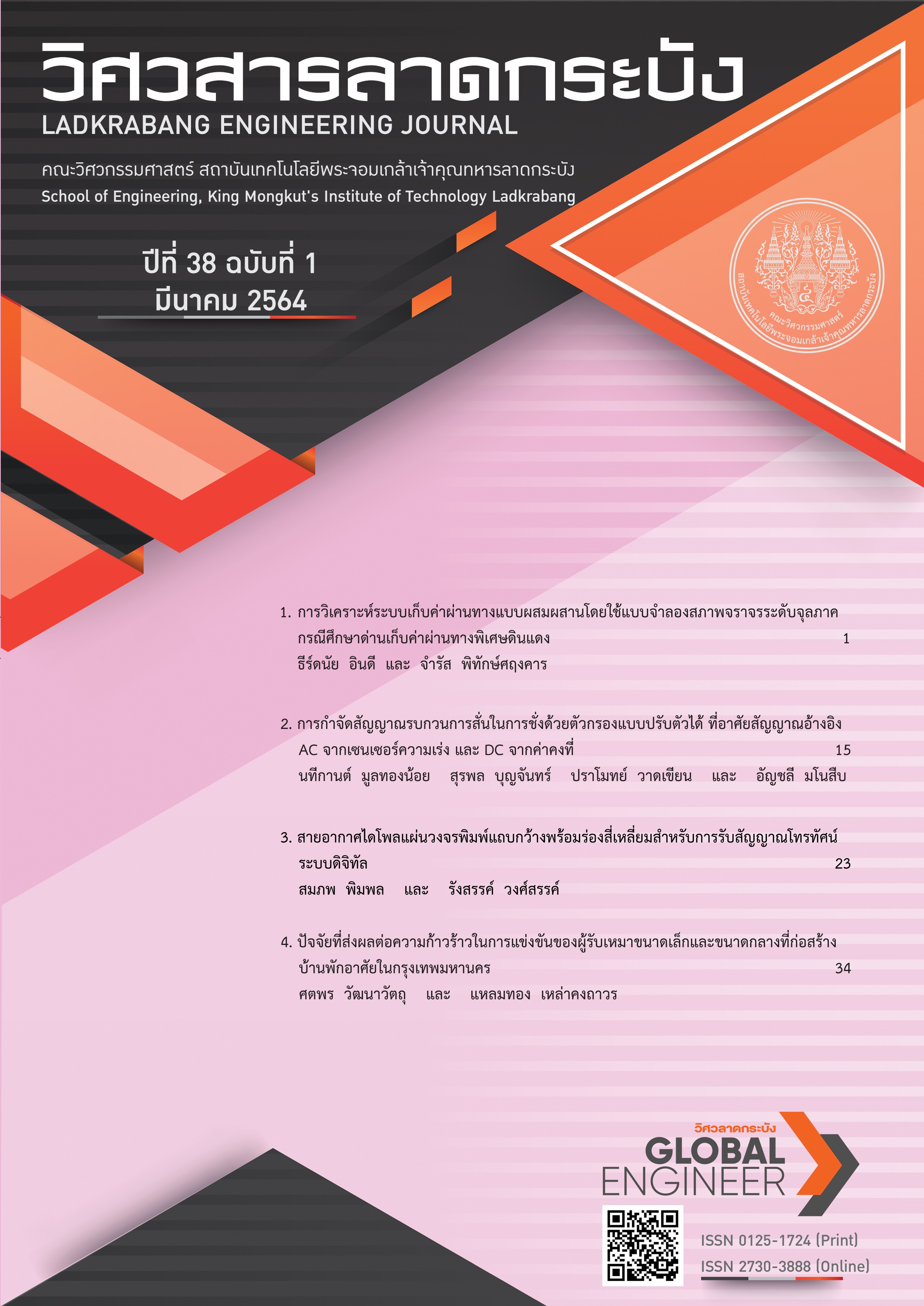Factors Influencing Competitive Aggressiveness of Small and Medium Housing Contractors in Bangkok
Keywords:
factors, competitive aggressiveness, housing construction, Confirmatory Factor AnalysisAbstract
Nowadays, construction is one of the industries that are impacted by society, economy and etc. Many contractors were out of business due to their poor administration. Competitive aggressiveness is regarded as one of the Entrepreneurial orientations. Contractors must have competitive aggressiveness for success in business. The literature review shows that no researches did about factors influencing competitive aggressiveness of small and medium contractors in Thailand. Thus, this research aims to study these factors. It is quality research method by using a questionnaire to collect data from people who have involve in management of housing construction contractors about the degree of importance of factors. The data were analyzed by testing the structure of factors. The factors were divided into 4 groups: Vision and Strategic management, Competitive performance, Client relationship, and Machines and raw materials management. By the results, it finds that the main factors that weigh the most importance are Competitive performance(35.33%), Vision and Strategic management(26.5%), Machines and raw materials management(19.56%), respectively.
References
U. Abdullahi., S.U. Kunya and S.A. Bustanman, “Impact of Competitive Aggressiveness on
Performance of Small and Medium Construction Firms in Nigeria”, FUTY Journal of the Environment, Vol.13, No.1, pp.65-74, 2019.
G.T. Lumpkin and G.G. Dess, “Clarifying the entrepreneurial construct and linking it to performance”, The Academy of Management Review, Vol. 21, No. 1, pp.135-172, 1996.
G.T. Lumpkin and G.G. Dess, “Linking Two Dimensions of Entrepreneurial Orientation to Firm performance: The moderating role of environment and industry life cycle”, Journal of Business Venturing, Vol. 16, No. 5, pp.429-451, 2001.
S. Vij and H.S. Bedi., “Relationship between Entrepreneurial Orientation and Business Performance”, The IUP Journal of Business Strategy, Vol. 9, No. 3, pp.17-31, 2012.
A. Rahman, M. Civelek and L. Kozubíková, “Proactiveness, Competitive Aggressiveness and Autonomy: A Comparative Study from the Czech Republic”, Quarterly Journal of Economics and Economic Policy, Vol.11, No.3, pp.631-650, 2016.
A. Ključnikov, J. Belás, L Smrčka, “The Role Of Risk-Taking And Competitive Aggressiveness In Management Of Smes”, Polish Journal of Management Studies, Vol.14, No.1, 2016.
H. Setiawan, B. Erdogan and S. O. Ogunlana, “Competitive aggressiveness of contractors: A study of Indonesia”, Procedia Engineering, Vol.125, pp.68-74, 2015.
W. Chokpromanan, “The affect entrepreneur characteristic on business success of store entrepreneur in Don Wai floating market, Nakhon Pathom province”, 2014.
B. M. Linyiru, R. P. Ketyenya, “Influence Of Competitive Aggressiveness On Performance Of State Corporations In Kenya”, International Journal of Entrepreneurship, Vol.2, No.1, pp.1-14, 2017.
Aroyeun, F. Taiwo, Adefulu, D. Adesoga , Asikhia, and U. Olalekan, “Effect of Competitive Aggressiveness on Competitive Advantage of Selected Small and Medium Scale Enterprises in Ogun State, Nigeria”, European Journal of Business and Management, Vol.10, No.35, pp.124-135, 2018.
S. Muhonen, “The Profitability of Competitive Aggressiveness: The Moderating Effect of Industry-Related and Organizational Factors”, Aalto University School of Business, 2017.
T. Leekulpitak, “The Components of Corporate Entrepreneurship of Rubber-Wood Businesses in Thailand”, Christian University of Thailand, 2017.
T. Yamane, “Statistic: An Introductory Analysis”, 2nd ed., New York:Harper and Row, 1967.
SPSS Training, “SPSS Training Series. IT Services”, Queensland University of Technology, 2001.
T. Silpcharu, “Research and statistical data analysis by SPSS and AMOS”, 13thed., S.R. Printing Mas Product, Thailand, 2012.
G. Rangsungnoen, “Factor analysis by SPSS and Amos for research”, Se-Education, Thailand, 2011.
J. Jr. Deegan, “On the Occurrence of Standardized Regression Coefficients Greater Than One”, Educational and Psychological Measurement, Vol.38, No. 4, pp.873-888, 1978.
Downloads
Published
How to Cite
Issue
Section
License
Copyright (c) 2021 Faculty of Engineering, King Mongkut’s Institute of Technology Ladkrabang

This work is licensed under a Creative Commons Attribution-NonCommercial-NoDerivatives 4.0 International License.
The published articles are copyrighted by the School of Engineering, King Mongkut's Institute of Technology Ladkrabang.
The statements contained in each article in this academic journal are the personal opinions of each author and are not related to King Mongkut's Institute of Technology Ladkrabang and other faculty members in the institute.
Responsibility for all elements of each article belongs to each author; If there are any mistakes, each author is solely responsible for his own articles.






